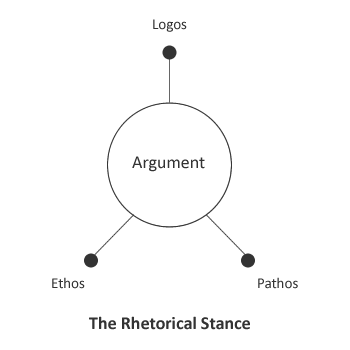Another key tenet of CMU-style of design thought centers around this concept of shaping and delivering arguments, based upon rhetorical motives of effective, persuasive communication. If you treat your product as an argument, it provides a critical lens and systematic framework for deconstructing what you do as a designer. Not merely pushing pixels around or type, image, animations on a blank canvas to make something “cool” and “trendy” but a guided, deliberate, intentional act of communication that directs a person’s behavior and response. It’s not art, but a design act. A rhetorical moment choreographed by the designer’s vision and goals, much like an orator/speaker.
An argument (in the rhetorical sense) has a basic set of three pivotal elements: logical structure (logos), human emotional response (pathos), and the presentational style or voice of delivery (ethos). Held together in balance of emphasis where neither one of these three overpowers the other (known as the rhetorical stance, from Wayne Booth), an effective argument is formed and executed by the speaker.

The relationship to design is apparent, if you consider a product like an iPod or Google’s search page or Dyson’s vaccuum cleaner as an argument. Not a work of art, not cool form, not mass-produced consumerism. As an argument: Its mechanical and operational abilities must function in concert with the emotional response, human affordances, usability/human factors, as well as with its brand, styling, colors, imagery to constitute a well-formed argument that draws the customer in, compelling her to purchase and use the product in her daily lifestyle as appropriate.
In essence, the argument (product) must be deemed useful, usable, and desirable–the invaluable holy trinity of design success! That success is most likely achieved when there is a proper balance of the elements (logos, pathos, ethos) that make up the argument. Engineering, human factors, brand/style must all work in concert effectively without any one overpowering the other. When something is heavy engineering, it’s too “techie” and over complicated for targeted users. When something is driven by usability concerns, it lacks elegance, beauty, aesthetic character which enliven a person’s life. When something is overly stylized and expressive, it becomes frivolous and useless, or even makes a mockery of basic functionality.
Each product is a form of communication that speaks out to potential customers, in subtle and unconscious ways, via the semantics of use, visual signals, formal affordances, and mechanical abilities (ie, features), as well as overal appearance and fit for the user’s situation or context.
Each product is an argument delivering a multi-pronged reason or set of appeals to persuade somebody to use it and enjoy it.
Ultimately, this rhetorical balance (the well-formed argument) is the central task of the designer: to envision and create products appropriate for human situations of use, drawing upon whatever knowledge is needed to get the job done.
